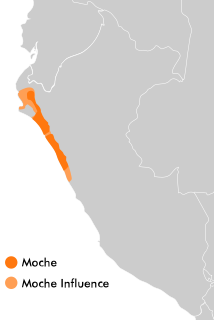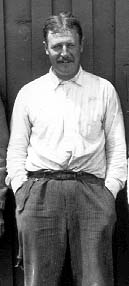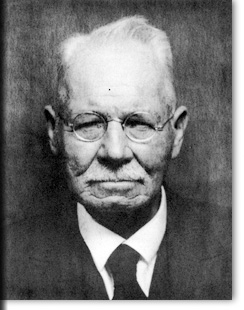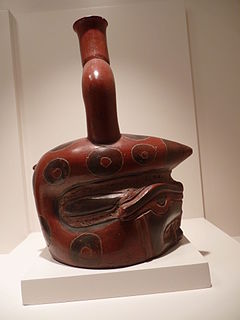
The Moche civilization flourished in northern Peru with its capital near present-day Moche, Trujillo, Peru from about 100 to 700 AD during the Regional Development Epoch. While this issue is the subject of some debate, many scholars contend that the Moche were not politically organized as a monolithic empire or state. Rather, they were likely a group of autonomous polities that shared a common culture, as seen in the rich iconography and monumental architecture that survives today.

Chan Chan was the largest city of the pre-Columbian era in South America. It is now an archaeological site in La Libertad Region 5 kilometres (3.1 mi) west of Trujillo, Peru.

George Clapp Vaillant was an American anthropologist.

Alfred Vincent Kidder was an American archaeologist considered the foremost of the southwestern United States and Mesoamerica during the first half of the 20th century. He saw a disciplined system of archaeological techniques as a means to extend the principles of anthropology into the prehistoric past and so was the originator of the first comprehensive, systematic approach to North American archaeology.
Gordon Randolph Willey was an American archaeologist who was described by colleagues as the "dean" of New World archaeology. Willey performed fieldwork at excavations in South America, Central America and the Southeastern United States; and pioneered the development and methodology for settlement patterns theories. He worked as an anthropologist for the Smithsonian Institution and as a professor at Harvard University.

Friedrich Max Uhle was a German archaeologist, whose work in Peru, Chile, Ecuador and Bolivia at the turn of the Twentieth Century had a significant impact on the practice of archaeology of South America.

The Peabody Museum of Archaeology and Ethnology is a museum affiliated with Harvard University in Cambridge, Massachusetts. Founded in 1866, the Peabody Museum is one of the oldest and largest museums focusing on anthropological material, with particular focus on the ethnography and archaeology of the Americas. The museum is caretaker to over 1.2 million objects, some 900 feet (270 m) of documents, 2,000 maps and site plans, and approximately 500,000 photographs. The museum is located at Divinity Avenue on the Harvard University campus. The museum is one of the four Harvard Museums of Science and Culture open to the public.
Alana Kathleen Cordy-Collins was Professor of Anthropology at the University of San Diego. She was an archaeologist whose primary specialization was Peruvian prehistory.
Joyce Marcus is a Latin American archaeologist and professor in the Department of Anthropology, College of Literature, Science, and the Arts at the University of Michigan, Ann Arbor. She also holds the position of Curator of Latin American Archaeology, University of Michigan Museum of Anthropological Archaeology. Marcus has published extensively in the field of Latin American archaeological research. Her focus has been primarily on the Zapotec, Maya, and coastal Andean civilizations of Central and South America. Much of her fieldwork has been concentrated in the Valley of Oaxaca, Mexico. She is known for her "Dynamic model", four-tiered hierarchy, and her use of interdisciplinary study.
Margaret Elizabeth Ashley-Towle was possibly the earliest professional woman in Southeast archaeology. She was born in Atlanta, Georgia to Claude Lordawick Ashley, a chief of the Atlanta city council, and Elizabeth Miller, the daughter of Captain Hiram Miller, a veteran of the Federal army.
William Andrew "Bill" Saturno is an American archaeologist and Mayanist scholar who has made significant contributions toward the study of the pre-Columbian Maya civilization. As of February 2015, Saturno holds a position as assistant professor in Archaeology at Boston University's (BU's) College of Arts and Sciences (CAS). He is also the director of the Proyecto San Bartolo-Xultun at the Instito de Antropologia e Historia in Guatemala, a national space research scientist at the Marshall Space Flight Center, as well as a research associate at the Peabody Museum at Harvard University. Prior to his position at BU, Saturno was a lecturer at the University of New Hampshire.
Joe Ben Wheat (1916–1997) was an American archaeologist, curator, teacher, and author known for his expertise on blanket weavings and textiles of the Navajo and other Indians in Arizona, New Mexico, and Colorado. His research focused on Mogollon, Anasazi, Great Plains Paleo-Indian, and African Paleolithic archaeology.

The Andean civilizations were complex societies of many cultures and peoples mainly developed in the river valleys of the coastal deserts of Peru. They stretched from the Andes of southern Colombia southward down the Andes to Chile and northwest Argentina. Archaeologists believe that Andean civilizations first developed on the narrow coastal plain of the Pacific Ocean. The Caral or Norte Chico civilization of Peru is the oldest known civilization in the Americas, dating back to 3200 BCE.

James L. Swauger was an American archaeologist known for his work on the petroglyphs of the Ohio River valley of the United States. A native of West Newton in Westmoreland County, Pennsylvania, he moved to the Pittsburgh suburb of Edgewood in his youth; there he lived for most of the rest of his life.
Ripley Pierce Bullen (1902–1976) was Curator Emeritus at the Florida Museum of Natural History at the University of Florida, where he was the Department Chair of Social Sciences for a period of seventeen years (1956–1973). He was an archaeologist primarily associated with the Southeastern United States and Florida, and in his later years he was known as the "dean of Floridian archaeology". He also completed fieldwork in the American Southwest, the New England states, Central America, and the Greater and Lesser Antilles.
David Michael Pendergast, is an American Archaeologist, and is most famous for his work at Altun Ha and Lamanai, Belize. He received a Bachelor of Arts in Anthropology in 1955 from the University of California, Berkeley, and earned his Ph.D. in 1961 at the University of California, Los Angeles, studying with Clement Meighan. He was later married to Elizabeth Graham, also a Mesoamerican Archaeologist.
Christopher B. Donnan is an archaeologist. He has researched the Moche civilization of ancient Peru for more than fifty years, conducting numerous excavations of Peruvian archaeological sites. Donnan has traveled the world photographing Moche artwork for purposes of publication, recording both museum artifacts and private collections that would otherwise be unavailable to the public. He has published extensively, both academically and for the general public.
Donald Collier was an archaeologist, ethnologist, and museologist. He was known primarily for his work in Ecuadorian and Andean archaeology and spent most of his career at the Field Museum of Natural History.

Caballo Muerto is an archaeological complex located on the northern coast of Peru, in the Moche Valley, in the Laredo District of La Libertad Region. It represents a series of mound sites that span both the Initial Period and the Early Horizon.
Richard Lewis Burger, Ph.D., is an archaeologist and anthropologist from the United States. He is currently a professor at Yale University and holds the positions of Charles J. MacCurdy Professor in the Anthropology Department, Chair of the Council on Archaeological Studies, and Curator in the Division of Anthropology at the Peabody Museum of Natural History. He has carried out archaeological excavations in the Peruvian Andes since 1975, publishing several books and many articles on Chavin culture, a pre-Hispanic civilization that developed in the northern Andean highlands of Peru from 1000 BC to 400 BC. Burger is married to Lucy Salazar, a Peruvian archaeologist and long time collaborator on many research projects. His former doctoral student Sabine Hyland has become well-known as an Andean anthropologist.








